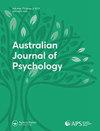一项系统综述和实证调查:青少年欺凌受害和焦虑亚型
IF 1.6
4区 心理学
Q1 PSYCHOLOGY, MULTIDISCIPLINARY
引用次数: 2
摘要
摘要目的众所周知,欺凌受害者与青少年社交焦虑症和广泛性焦虑症有关。研究1报告了一项系统综述,以检验这些关系。研究2采用了一项调查来调查公开、名誉和关系欺凌与社交焦虑症、广泛性焦虑症、分离焦虑症、恐慌症和强迫症的自我认可之间的关系。方法研究1包括对2011年至2021年间发表的文献进行系统综述。使用多种来源,使用不同组合的关键词来确定潜在的合格研究,并遵循PRISMA指南。纳入研究的质量使用关键评估工具进行评估。研究2通过338名12-18岁的高中生完成的在线问卷收集数据 年。结果研究1表明,欺凌受害研究将焦虑结果局限于社交焦虑症和广泛性焦虑症。研究结果还表明,显性和隐性欺凌类型通常没有定义。研究2发现,隐性欺凌类型(声誉和关系型)可以唯一地预测所有焦虑亚型的水平增加,而显性欺凌则没有。除强迫症外,关系欺凌是所有焦虑亚型的最佳预测因子。结论这些结果表明,需要考虑不同类型的欺凌,并需要更广泛地评估焦虑亚型症状。关键点关于这个话题已经知道的内容:欺凌受害者与青少年的社交焦虑症和一般焦虑症有关。先前的研究已经确定了三种欺凌受害亚型;公开的,和两种隐蔽的类型是声誉和关系。隐性欺凌受害与抑郁和社交焦虑症状的关系比显性更为密切。本主题补充道:明显的欺凌受害者并不能预测广泛性焦虑症、社交焦虑症、分离焦虑症、恐慌症和强迫症的自我认可。隐性欺凌受害者可预测分离焦虑症、恐慌症和强迫症。欺凌受害的亚型表现出与一系列焦虑症症状的独特关系,而不仅仅是一般性焦虑症和社交焦虑症。本文章由计算机程序翻译,如有差异,请以英文原文为准。
A systematic review and empirical investigation: bullying victimisation and anxiety subtypes among adolescents
ABSTRACT Objective Bullying victimisation is well known to be associated with social anxiety disorder and generalised anxiety disorder among adolescents. Study 1 reports on a systematic review to examine these relationships. Study 2 employed a survey to investigate the relationship between overt, reputational, and relational bullying with self-endorsement of social anxiety disorder, generalised anxiety disorder, separation anxiety disorder, panic disorder, and obsessive-compulsive disorder. Method Study 1 consists of a systematic review of the literature published between 2011 and 2021. Multiple sources were used to identify potentially eligible studies using keywords in varying combinations and the PRISMA guidelines were followed. The quality of included studies was assessed using a critical appraisal tool. Study 2 collected data through an online questionnaire completed by 338 high-school students aged 12–18 years. Results Study 1 demonstrated that bullying victimisation research limits anxiety outcomes to social anxiety disorder and generalised anxiety disorder. Results also demonstrated that overt and covert bullying types are typically not defined. Study 2 found that covert bullying types (reputational and relational) uniquely predicted increased levels of all anxiety subtypes, while overt bullying did not. Relational bullying was the best predictor of all anxiety subtypes, except obsessive-compulsive disorder. Conclusion These results suggest the need to consider different types of bullying and the need to assess anxiety subtype symptoms more broadly. KEY POINTS What is already known about the topic: Bullying-victimisation is associated with social anxiety disorder and general anxiety disorder among adolescents. Previous research has identified three bullying victimisation subtypes; overt, and two covert types being reputational and relational. Covert bullying victimisation is more strongly related to depression and social anxiety symptomology than overt. What this topic adds: Overt bullying victimisation does not predict self-endorsement of generalised anxiety disorder, social anxiety disorder, separation anxiety, panic disorder, and obsessive-compulsive disorder. Covert bullying victimisation predicts separation anxiety disorder, panic disorder, and obsessive-compulsive disorder. Subtypes of bullying victimisation demonstrate unique relationships with a range of anxiety disorder symptomology beyond that of generalised anxiety disorder and social anxiety disorder.
求助全文
通过发布文献求助,成功后即可免费获取论文全文。
去求助
来源期刊

Australian Journal of Psychology
PSYCHOLOGY, MULTIDISCIPLINARY-
CiteScore
5.50
自引率
0.00%
发文量
19
期刊介绍:
Australian Journal of Psychology is the premier scientific journal of the Australian Psychological Society. It covers the entire spectrum of psychological research and receives articles on all topics within the broad scope of the discipline. The journal publishes high quality peer-reviewed articles with reviewers and associate editors providing detailed assistance to authors to reach publication. The journal publishes reports of experimental and survey studies, including reports of qualitative investigations, on pure and applied topics in the field of psychology. Articles on clinical psychology or on the professional concerns of applied psychology should be submitted to our sister journals, Australian Psychologist or Clinical Psychologist. The journal publishes occasional reviews of specific topics, theoretical pieces and commentaries on methodological issues. There are also solicited book reviews and comments Annual special issues devoted to a single topic, and guest edited by a specialist editor, are published. The journal regards itself as international in vision and will accept submissions from psychologists in all countries.
 求助内容:
求助内容: 应助结果提醒方式:
应助结果提醒方式:


